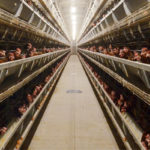As the poultry industry continues to evolve, understanding the intricacies of chicken cage prices in 2025 is crucial for both seasoned poultry farmers and new investors. With the growing demand for efficient and humane poultry farming practices, selecting the right chicken cage system can significantly impact your business’s profitability and sustainability. This guide will provide you with valuable insights into the cost of chicken cages, the factors influencing these prices, and tips for making informed investment decisions.

Introduction
The poultry farming industry is poised for substantial growth in 2025, driven by advancements in farming technology and increasing global demand for poultry products. For poultry farmers and investors, selecting the right chicken cage system is a critical decision that can influence productivity, animal welfare, and overall profitability. This guide explores the various factors affecting chicken cage prices, offering a comprehensive overview for those looking to invest in poultry farming.
Understanding Chicken Cage Prices
Chicken cage prices in 2025 will vary based on several factors, including the type of cage, materials used, and additional features. Understanding these factors can help you make informed decisions when setting up or expanding your poultry farm.
Types of Chicken Cages
- Battery Cages: These cages are designed for high-density farming, maximizing space utilization. While they are cost-effective, they have been criticized for poor animal welfare standards. Prices for battery cages range from $100 to $180 per unit.
- A-Type Cages: Known for their space-saving design, A-type cages are stacked vertically. These are suitable for both small and large-scale farms, with prices ranging from $100 to $200 per unit.
- H-Type Cages: Offering more space and comfort, H-type cages are popular in commercial egg production. Prices typically range from $180 to $300 per unit.

Factors Influencing Chicken Cage Prices
Several factors can influence chicken cage prices, and understanding these can help you budget effectively for your poultry farm.
- Material Quality: High-quality materials like galvanized steel increase durability and resistance to corrosion, but they come at a higher cost. Investing in quality materials can reduce long-term maintenance expenses.
- Brand Reputation: Established brands often offer premium products with a track record of reliability. While these may have a higher initial price, they can provide peace of mind regarding quality and performance.
- Cage Design and Features: Advanced features such as automated feeding and watering systems, ventilation, and manure removal can increase cage prices but improve efficiency and animal welfare.
- Market Conditions: Prices can fluctuate based on regional market conditions, availability of materials, and demand for poultry products.
Cost of 10000 chickens cage in poultry farm
For a medium-sized farm housing 10,000 birds, the cost of setting up chicken cages can vary significantly. Here’s an approximate breakdown:
- Cages: Depending on the type and quality, expect to spend between $7,000 and $15,000 on cages alone.
- Infrastructure and Housing: Building necessary structures can add an additional $5,000 to $10,000.
- Feeding and Watering Systems: A reliable system can cost between $1,000 and $1,500.
- Operational Expenses: Ongoing costs such as feed, veterinary care, and labor should also be considered.

Making Informed Investment Decisions
Investing in the right chicken cage system requires careful planning and consideration. Here are some tips to guide your decision-making process:
- Conduct a Feasibility Study: Analyze the costs and potential returns of your poultry farm to ensure financial viability.
- Consider Animal Health: Opt for chicken cage systems that promote better living conditions for your birds, as this can enhance productivity and meet ethical standards.
- Plan for Long-Term Sustainability: While initial costs may be higher for quality cages, the long-term benefits in terms of durability and efficiency can outweigh these expenses.
- Stay Informed: Keep abreast of industry trends and advancements in poultry farming technology to make informed decisions.
Conclusion
Investing in chicken cages is a significant decision that can impact the success of your poultry farm. By understanding the factors influencing chicken cage prices and considering long-term sustainability and animal welfare, you can make informed decisions that will benefit your business in 2025 and beyond. Whether you’re a seasoned farmer or a new investor, this guide provides the insights needed to navigate the complexities of the poultry farming industry.
Call to Action
For more information on poultry farming and to explore high-quality chicken cage options, contact reputable chicken cage suppliers and manufacturers. Stay informed about industry trends and advancements to ensure your poultry farm’s success in 2025 and beyond.






